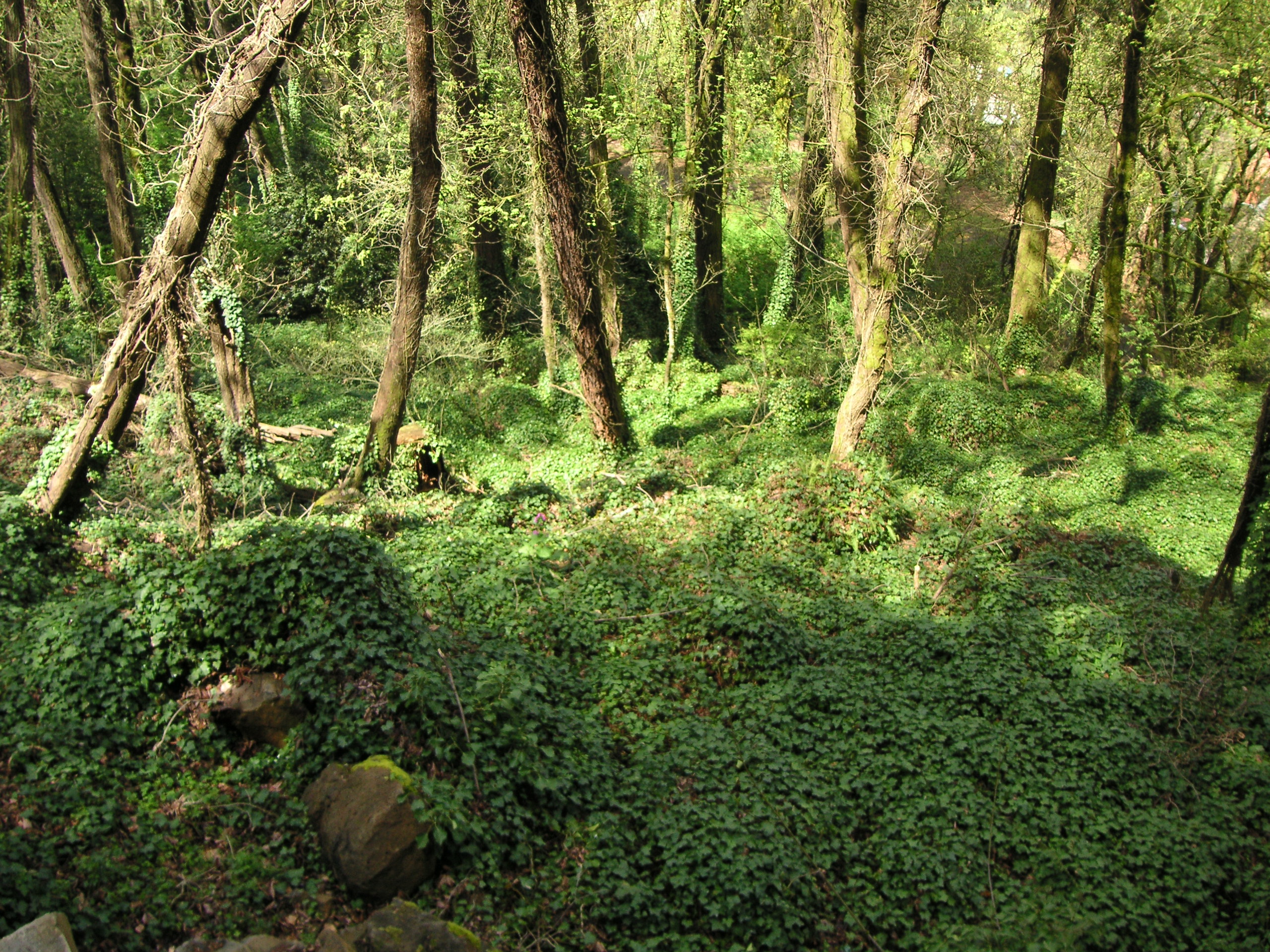Ivy, English or Atlantic (Hedera helix or Hedera hibernica) on May 9, 2010
Submitter has sample
EDRR Status: Local expert notified
Description of specimen
English Ivy, English Holly, Fox Squirell, and the Common Opossum
The main invader and the reason for this report is English Ivy. It has completely blanketed the park. It is killing the trees. Several trees have fallen this year. Talked to OC parks and rec. and they have no plans or interest (funds) in removing.



How would you suggest removal of 20acres of ivy on a steep slope?
Are their fines associated with dumping this invasive species as part of your lawn clippings in a public park?
How should the removed plants be transported and discarded?
Reporter
May 9, 2010, 12:23 p.m.
Thanks for reporting this infestation of English Ivy. Ivy is a significant problem invader in forest communities within Clackamas County. The Clackamas Soil and Water Conservation District is working with regional partners to map and catalog known infestations of ivy to help prioritize future control efforts.
Unfortunately, the resources needed to control this invader are limited in relation to the overall need. As such we currently offer technical information to local landowners to help them develop a management strategy that is effective to their particular site conditions and needs. If you would like assistance to control this population please feel free to contact the Conservation District.
Follow these simple steps for an ivy free landscape.
• Carefully cut vines climbing trees and pull these vines away from the base of the tree.
• Pull vines and roots from ivy creeping along the ground. Don’t forget your gloves and scissors.
• Dispose of cut vines in yard waste, or dry out completely and compost
• Re-visit the site regularly to control re-growth
For more detailed information on English ivy and its control follow the link below:
http://your.kingcounty.gov/dnrp/library/water-and-land/weeds/BMPs/english-ivy-control.pdf
Again thank you for reporting this invader. Feel free to contact me if you have additional questions.
Sam
______________________________________
Samuel Leininger
WeedWise Program Manager
Clackamas Soil & Water Conservation District
221 Molalla Ave. Suite 102
Oregon City, OR 97045
503-655-3144 x118
samuel.leininger@or.nacdnet.net
www.conservationdistrict.org
______________________________________
Samuel Leininger
May 11, 2010, 10:27 a.m.
Thank you for your timely response. However, the site you referred me to only answered some of my questions regarding treatment methods. As a county representative I am sure you are aware of the latest state restrictions placed on this species. Please advise on the legal issues related to this invasive species.
Please answer these questions directly:
1. Are their fines associated with dumping this invasive species as part of your lawn clippings in a public park?
- I have observed adjacent owners dumping this plant in the park, evidence of this is easily acquired.
2. How should the removed plants be transported and discarded?
- If one was to remove/kill the ivy in the park it is unfeasible to leave it on site and now illegal to transport within the state. To my knowledge no distinction has been made between live and dead ivy. Stacking and drying would create a fire hazard near homes. What is the preferred method of disposal.
Thaddeus Niebel
Reporter
May 11, 2010, 1:03 p.m.
I appreciate your attention to invasive species issues. English ivy is one of the worst invaders in Clackamas County, and has unfortunately widespread across our region. The recently inacted ban on the sale and transport of ivy effectively prohibits the continued sale and distribution of ivy within the state of Oregon. This law does allow for the collection and transport of prohibited weeds from infested areas as long as they will not be used for propagation or sale(OAR 603-052-1200 4d).
That said I would like to clarify my remarks by saying that I am not a lawyer. If you are seeking a definitive answer regarding legal issues associated with invasive species I suggest you contact the Oregon Department of Agricluture for clarification at the address below.
Oregon Department of Agricluture
Plant Division, Noxious Weeds
635 Capitol Street NE
Salem, OR 97301-2532
503-986-4621
http://www.oregon.gov/ODA/PLANT/WEEDS/
In regard to your first question, it is my understanding that enforcement of the noxious weed control laws can be enforced by Oregon Department of Agriculture or a county weed control district. Unfortunately, Clackamas County has not elected to maintain a weed control district. That aside, the circumstances you described may be a violation of litter regulations described in Oregon City Municpal Code (section 12.16.020 A 2). I recommend that you contact Oregon City Code enforcement for more information.
Oregon City Code Enforcement
320 Warner-Milne Rd.
Oregon City, OR 97045
503-496-1559
In regard to your second question, proper disposal of ivy depends largely on the size of the infestation. Small patches of ivy can be disposed of as yard waste. Larger patches should be handled on site. Ivy can be piled and allowed to dry out and decompose, Covering the pile can speed the decomposition process. The vines can also be wrapped into medium sized bundles and left on site to dry up. Managment and disposal of the ivy within the park should be the responsibility of the parks department. I will contact them and attempt to facilitate effective control.
I certainly understand your frustration in regard to ivy control, and it is the same frustration that many land managers feel regarding this species. unfortunately because this species is so widespread, resources may not be available for control.
Thanks again for your interest and dedication to this issue. If you have any additional questions please feel free to contact me directly.
Sam
______________________________________
Samuel Leininger
WeedWise Program Manager
Clackamas Soil & Water Conservation District
221 Molalla Ave. Suite 102
Oregon City, OR 97045
503-655-3144 x118
samuel.leininger@or.nacdnet.net
www.conservationdistrict.org
______________________________________
Samuel Leininger
May 12, 2010, 3:29 a.m.